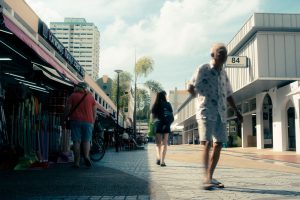All images by Xue Qi Ow Yeong for RICE Media.
When I was studying at Republic Polytechnic, I would pass through Woodlands MRT station five times a week. I frequently ate the $2.50 chicken rice from an MRT station shop called Tuan Tuan Puan Puan. Its cheap, tasty, and filling offerings made it a staple visit for a broke student.
Other times, after a long day of classes and training sessions, my friends and I would grab a drink or a snack from Tuan Tuan and spend an hour hanging around at the ‘Titanic’—so-called because of the thick pillars holding up the train tracks that resemble the RMS Titanic’s signature smokestacks—before catching the last train home.
ADVERTISEMENT
Recently, I ended up back in Woodlands and was shocked by how much the station had changed in the past few years. The construction of the Thomson-East Coast Line has given the station a fresh revamp, with about half the shops at the foot of the station replaced. The $2.50 chicken rice has gone up in price ($3.50! By the gods!), and the stall is no longer manned by the same people I used to recognise, like the young, skinny Chinese guy who would make the chicken rice.
It got me thinking—my interactions with the people in these shops were limited to buying meals. I knew nothing about them, some shops I didn’t even notice until they were shuttered. These aren’t just faces behind a counter, they serve important functions in our daily commutes. Looking back, I can’t help but wonder what I missed by not seeing beyond the surface.
And though more than three million trips are taken on the MRT system every day, I believe most Singaporeans don’t know anything about the shops they see or patronise regularly, either.
Anecdotally, most of the friends I’ve asked agreed that MRT station shops add something to their environment. One of them told me that the newer Thomson-East Coast Line stations, many of which don’t have shops yet, look like ghost towns. Another said that if these shops disappeared, he would feel like there was “something missing”.
In a bid to find out more about what exactly that ‘something’ is, I embarked on a cross-country adventure with my photographer, Xue Qi.
Lovely Lavender
I’m curious to see what I’ll find at Lavender. Besides being a residential estate, it also houses a few hotels and (of course) the Immigrations and Checkpoints Authority (ICA) building.
Walking down the line of shops next to the station exit, I pass various shops from big chains such as Luckin Coffee and McDonald’s, but the one that catches my eye is Chef Ibu—it sells a variety of different dishes like bee hoon, nasi lemak, and sambal goreng at economical prices.

The woman at the counter, Nora, cheerily hails me. “What you want?” The 50-year-old’s voice is loud even though she has a face shield on. I’m not buying anything, but she’s happy to chat about why she does what she does.
She tells me, “Money is good, work is good, I’m happy to work because I meet people.”
Nora has been working here part-time for five years, though the store has been around for 20 years. As I’m chatting with her, I’m briefly interrupted by a customer. Nora asks him if he wants “辣椒” (chilli) on his dish.
As he leaves, she turns to me. “See? You work in (this) industry you can be bilingual. Because the people here are all Chinese, Indian, Singaporean lah. Basically, we are Singaporean lah. 天天 (daily) also can lah.” She rattles off a string of phrases in various languages.
ADVERTISEMENT

Despite the differences, Nora finds a way to connect with the wide range of people she meets. It makes sense when you consider that everyone across the country has to come down to ICA to settle passport matters.
Her friendliness is a transferable skill, too. If anything happens to her job here, she’s thinking about upgrading herself and working in a field like hospitality.
“I’m looking at customer service. Now I also serve customers, only in a different industry, F&B. So I can probably work in a hotel reception as a guest relationship (manager).”
Red Hot Redhill
Further down the green line at Redhill, I chance upon BakeryPoint, a small shop selling affordable pastries like sausage bread and chocolate buns.

Mdm Leow, 66, initially has a stern demeanour. But once she gets talking, she’s pretty forthcoming and even cracks a few jokes.
She tells me in Mandarin that she’s been working here for 12 years, for as long as the store has been around. She’s longtime friends with the owner of the BakeryPoint franchise—which is why she’s still his employee.
But recently, business has been bad, she says sadly. There have been fewer customers. There used to be an empty field nearby where migrant workers would hang out, but ever since a new condominium replaced the field, those customers stopped coming by the shop.
Rental prices have also gone up.
“Everything has gone up,” she sighs. She says her boss tried to sell the shop, but no one wanted to take over because it was too expensive.
Maybe a drop in foot traffic and a rise in prices drove out the shops at Woodlands, too—though I wouldn’t know. I’m starting to realise how striking up a single conversation can reveal so much about a neighbourhood’s changes and their impact.

While there are customers who irritate Mdm Leow when they don’t read the promotions properly (“The store is already very hot, it makes me feel hot from anger”), her boss is the reason she hasn’t retired yet.
“The customers threaten to complain. Complain lah! My boss won’t fire me just because of one complaint.”
Beyond their friendship, she appreciates the fact that he listens to his employees’ feedback and treats them well. If he wasn’t so nice, she tells me, she would have retired last year.
No Signboard Admiralty Newspaper Store
Mr Chew, 67, is another person who’s running an MRT station shop instead of retiring.
Nestled under the escalator in Admiralty MRT station is a shop that immediately stops me in my tracks. It houses a veritable collection of old snacks—those pancake biscuits, cotton candy, gem snacks, Push Pops, and more. Xue Qi spends $3 on a bag of wheel crackers (she later admits it was such a huge portion that she had trouble finishing it).

The shop seems like a relic of the past, so I’m surprised when Mr Chew tells me it has been here for just five years. It was originally a newspaper store, but he’s trying to bring more items in—hence the retro snacks, face masks, cold drinks, and more.
I ask Mr Chew if his shop has a name. He says no.
“My supplier ask me what address, I just say newspaper store. Selling newspaper.”
He seems friendly but resigned when he tells me his business is “surviving, but getting worse”.
What keeps his business going are his most popular purchases: drinks, fishcakes, prawn crackers, and the Shin Min Daily News, which sells 200 copies daily.

Despite his worries, he says he won’t close down unless he decides to retire for good. When will that happen? He doesn’t know either.
“Many people want this area; it’s a good location.” And it looks like Mr Chew isn’t ready to give it up just yet.
Chinese Garden Camaraderie
Chinese Garden Food Shop, aptly named after its MRT station, serves a variety of Chinese food, including mala hotpot, noodles, and Chinese hamburgers (sandwiches made with leavened flatbread and pork).
Mr Gao, 42, works behind the counter. He says a lot of their regulars are migrant workers from China. He’s also from China, so “we greet each other,” he tells me in Mandarin.

Another worker, Jing Li, a 42-year-old Malaysian, tells me that the language barrier with customers who can’t speak Mandarin is sometimes a problem. “If we can communicate, then we chat; if we can’t, then we just gesture.”
Both Mr Gao and Jing Li work here to earn money to support their families. Jing Li says the conversion rate here is better than that of her home country of Malaysia.
I sense a feeling of camaraderie between the workers—the recognition of being an immigrant in a foreign land, trying to earn a living and provide for your family.


Samiah, an SMRT staff member, explains that the Chinese Garden MRT station used to be a lot quieter. There wouldn’t be much traffic besides tourists visiting the Chinese and Japanese Gardens.
But in the past few years, a new condominium and residential estate were constructed in this area. And construction—at the Science Centre’s new site and the new residential estate of Tengah—has brought workers through this station. It’s probably why Chinese Garden Food Shop is seeing such brisk business.

Socialising in Serangoon
Over in Serangoon, there’s 010 Pte. Ltd., a small shop selling old snacks and toys. It’s nestled in a corner near the North East Line exits, so inconspicuous that I could’ve (and have) missed it before in the peak hour rush.

The woman running the store, who declined to give me her name, is in her 70s. She reminds me of my grandmother, who used to live in Serangoon. And it’s not just her appearance, but also how she’s chatting animatedly in Chinese dialect with two fellow elderly ladies. I find out that these are customers who turned into friends.
The woman tells me in Mandarin that she’s been working here part-time for eight years— a way to pass the time and occupy herself. I ask if she’s retired, and one of her friends laughs: “退而不休! (Retired but not idle!)”
Her friend tells me they live nearby and visit the shop once or twice a week since it’s been here for a while. I get the feeling that they aren’t visiting the shop just to buy things, but because it provides a reason to connect with other people. Especially for the old folks living in the area, shops like these are a way to connect with other people to avoid loneliness and social isolation.

I’m also curious—has the opening of NEX affected their business at all?
“No,” she tells me nonchalantly. “It’s a shopping mall; what they sell is expensive. We sell cheap things. And we’re serving a different audience.”
It’s probably also why the 7-Eleven around the corner recently shuttered while this shop remains standing.
I reach for a container of fried anchovies, and she asks me, “Are you sure you want that? It’s expensive.” It’s $7.50. I decide to get the $5.50 bag of ikan bilis instead.

That Special Something
After my travels, I have a theory about what exactly MRT station shops bring to their respective neighbourhoods. There are three aspects: cost, character, and community.
These shops sell food or daily essentials at prices that feel affordable to the everyman. While inflation may have driven prices up everywhere, MRT station shop food is still cheaper than what you would find in an air-conditioned food court in a mall. No $6 chicken rice here.
The other thing that keeps people returning is character, something that makes a small shop stand out from the typical big brands and franchises. Whether it’s Admiralty’s retro snacks or Lavender’s local fare, these shops don’t feel like just another branch of Famous Coffee Brand or Fast Food Chain Outlet #263.
But behind all this is a sense of community. These shops are a source of comfort and consistency. They’re not just sites of consumption; they provide daily pockets of connection. They’re there for you when you start your day; they’re there for you when you finally drag yourself home, tired but relieved.
They’re the heart and soul of our MRT stations, offering a unique charm that major franchises simply can’t replicate. Losing them would mean losing a piece of our daily rhythm and local identity.
How many of us have friends or acquaintances on our daily commutes? When scheduling meetups takes weeks of advance notice, MRT station shops become serendipitous spots where familiar faces become a regular part of our routine. A simple conversation or two could turn these passing encounters into lasting friendships.
We’re always seeking connections with others—maybe we should start in our own neighbourhoods.





